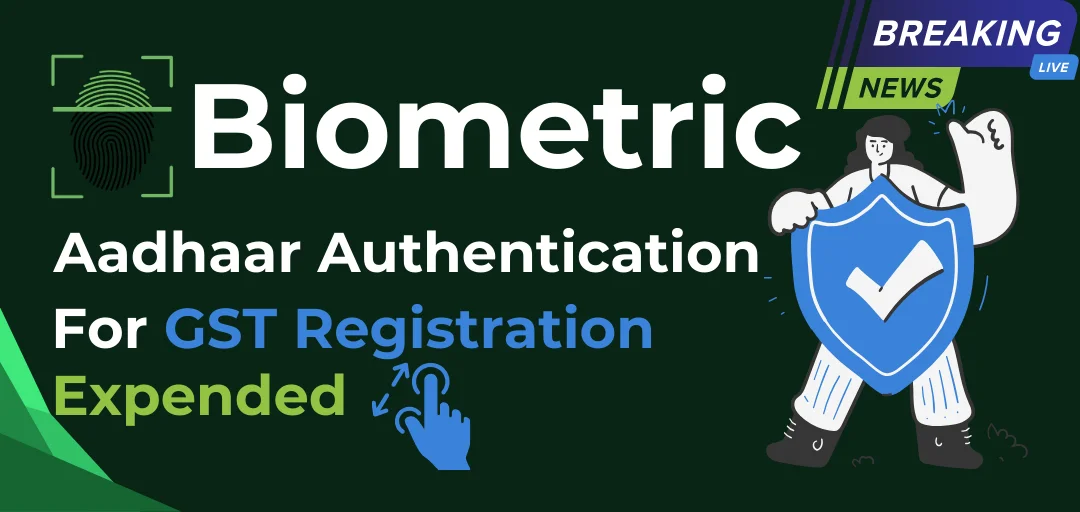Advisory for Biometric-Based Aadhaar Authentication and Document Verification for GST Registration Applicants
The GST Council continues its stride toward enhanced tax compliance and fraud prevention with the latest advisory mandating biometric Aadhaar verification and document verification for GST registration applicants. This advisory now applies to Chhattisgarh, Goa, and Mizoram, expanding the scope of the initiative previously introduced for Haryana, Manipur, Meghalaya, and Tripura on December 8, 2024.
By implementing Aadhaar-based biometric authentication, the GST system aims to strengthen the registration process, reduce fraudulent registrations, and streamline compliance for businesses. Let’s delve deeper into what this means for applicants in these states and how the process integrates with the broader GST framework.
What is Biometric Aadhaar Verification for GST Registration?
Biometric Aadhaar verification leverages an individual’s biometric data, such as fingerprints and iris scans, to validate their identity against Aadhaar records. Unlike traditional document-based verification methods, biometric authentication eliminates the risk of forgery and ensures genuine applicants gain GST registration.
This verification is now mandatory for GST applicants in eight states:
- Initially introduced: Haryana, Manipur, Meghalaya, and Tripura (from December 8, 2024).
- Now expanded to: Chhattisgarh, Goa, and Mizoram (latest notification).
Why Aadhaar-Based Biometric Verification?
The introduction of biometric Aadhaar verification is a response to challenges faced by the GST system, including fake registrations and fraudulent input tax credit (ITC) claims. The process enhances the system in the following ways:
- Fraud Prevention: By directly linking GST registration to Aadhaar biometrics, the system prevents impersonation and fake entries.
- Improved Accuracy: The use of advanced technology ensures error-free identity verification.
- Increased Transparency: Tax authorities gain better visibility into genuine and non-genuine applicants.
Applicability of the Advisory
States Currently Covered
- Haryana, Manipur, Meghalaya, Tripura (from December 8, 2024).
- Chhattisgarh, Goa, Mizoram (latest notification).
If you are a GST applicant in any of these states, you must comply with biometric Aadhaar verification and document submission requirements. Failure to do so may lead to delays or rejections of your GST registration.
Future Possibilities
Given the success of this initiative in curbing fraudulent registrations, it is likely that the biometric Aadhaar verification process will be expanded to more states in the near future.
How to Complete the Biometric Aadhaar Verification Process?
To comply with the biometric Aadhaar verification requirement, follow these steps:
- Locate Aadhaar Seva Kendra: Visit the nearest Aadhaar Seva Kendra or any designated center for biometric authentication.
- Submit Aadhaar Details: Provide your Aadhaar number to initiate the verification process.
- Biometric Authentication: Your biometric data, including fingerprints and iris scans, will be captured and matched with the Aadhaar database.
- Document Verification: Submit supporting documents for further validation.
- Confirmation: Once the verification is complete, you will receive confirmation, allowing your GST registration to proceed.
Documents Required for Biometric Aadhaar Verification
Applicants should carry the following documents:
- Aadhaar card with updated details.
- PAN card of the business owner.
- Proof of business establishment.
- Address proof of business premises.
Integration with Aadhaar Authentication Framework
This move builds on the existing Aadhaar authentication framework introduced earlier by the GST Council. Applicants from Haryana, Manipur, Meghalaya, and Tripura have already been using biometric Aadhaar verification since the advisory issued on December 8, 2024.
By integrating biometric data, the GST system can now:
- Ensure the authenticity of registrants.
- Reduce manual errors in verification.
- Eliminate the possibility of fake registrations that exploit loopholes in the system.
Key Benefits of Biometric Aadhaar Verification
- Enhanced Security: The use of biometrics ensures only genuine individuals can obtain GST registration.
- Reduced Tax Fraud: The system prevents fraudulent ITC claims arising from fake businesses.
- Streamlined Process: Biometric authentication simplifies the registration process for both applicants and tax authorities.
- Scalability: With its success in select states, this system can be easily scaled to cover all states in India.
Challenges and How to Overcome Them
Accessibility Issues
Remote areas in some states may have limited access to Aadhaar Seva Kendras.
- Solution: Authorities could establish more centers or offer mobile verification units.
Awareness Gaps
Many business owners may not be fully aware of the new requirements.
- Solution: GST authorities should launch awareness campaigns to educate applicants about biometric Aadhaar verification.
Preparing for the New GST Registration Process
If you are applying for GST registration in Chhattisgarh, Goa, or Mizoram, ensure the following:
- Update your Aadhaar details if there are any errors.
- Gather all necessary business documents.
- Locate the nearest Aadhaar Seva Kendra for biometric verification.
For businesses in Haryana, Manipur, Meghalaya, and Tripura, continue complying with biometric authentication and document verification guidelines issued in December 2024.
Conclusion
The introduction of biometric Aadhaar verification for GST registration applicants is a step forward in India’s ongoing efforts to enhance tax compliance and reduce fraud. With the system now covering eight states, including the recent addition of Chhattisgarh, Goa, and Mizoram, it’s clear that this initiative is setting a new standard for transparency and security in the GST framework.
By integrating technology like biometrics, the GST system is building a more robust framework for taxpayers. Businesses in affected states should prioritize compliance to avoid delays in their GST registration process.
Stay updated with the latest GST notifications to ensure seamless registration and tax compliance.
Our GST Services

All E-commerce Tax services
E-commerce tax services help online sellers navigate GST registration, compliance, return filing, TCS management, tax planning, and audits, ensuring efficient tax management and legal compliance.

GST Filing
GST filing is the process of submitting tax returns to the government, detailing sales, purchases, and taxes paid or collected, ensuring compliance with GST laws.

GST Registration
GST registration is the process where businesses obtain a GSTIN from the government, allowing them to collect taxes, claim input tax credits, and comply with GST laws.





